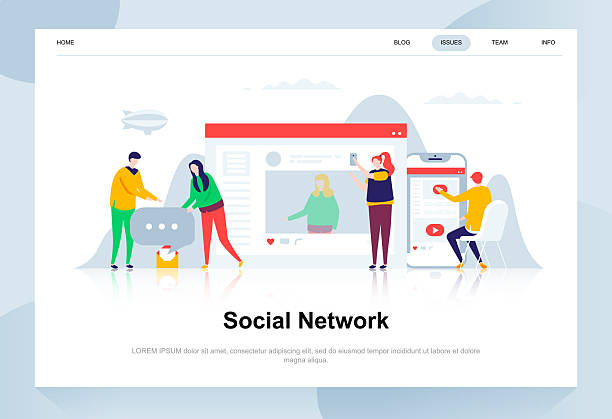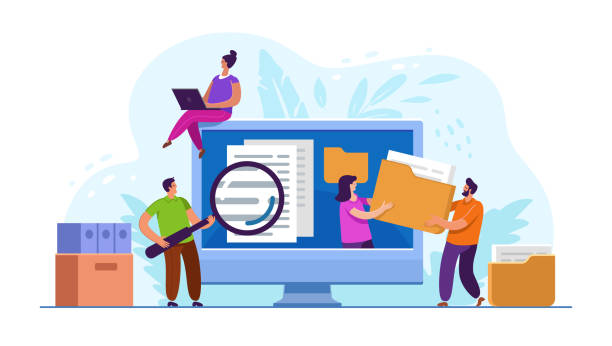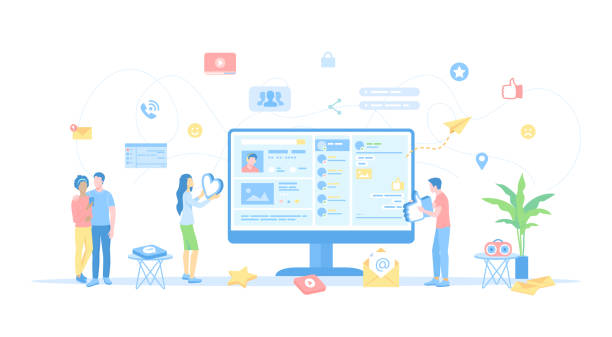Why is Secure Website Design Crucial?

In today’s digital world, where an increasing portion of our lives is moving online, #Secure_Website_Design is no longer an option, but an undeniable necessity.
Imagine having a website that stores sensitive user information or critical business data; a small weakness in #Website_Security can lead to loss of #User_Trust, irreparable financial damage, and even bankruptcy.
Have you ever considered how a simple breach can destroy your brand’s reputation in the blink of an eye? This section, as thought-provoking content and explanatory, addresses the fundamental importance of secure website design.
Every day, we hear news of widespread cyber attacks that target even large companies with massive security budgets.
Therefore, for small and medium-sized businesses, this issue becomes doubly important.
This is not just about data protection, but also about safeguarding user privacy and complying with international regulations such as GDPR.
Secure website design means creating a multi-layered defense shield against ever-increasing digital threats, from phishing attacks to SQL injection and malware.
Without strong security infrastructures, any investment in your website could be at serious risk, leading to losses instead of returns on investment.
Hence, prevention is always better than cure, and investing in security is an investment in the future of your business.
Did you know that poor online store design can drive away up to 70% of your potential customers? Rasaweb transforms your sales with professional and user-friendly e-commerce website design.
✅ Significant increase in sales and revenue
✅ Full optimization for search engines and mobile
⚡ [Get free consultation from Rasaweb]
Fundamental Concepts in Secure Website Design

To begin the secure website design process, understanding the basic concepts of web security is essential.
This section, in an educational and specialized manner, explains these principles.
One of the first and most important steps is using HTTPS protocol instead of HTTP.
HTTPS, using SSL/TLS certificates, encrypts the communication between the user’s browser and the website server.
This encryption ensures that exchanged data, including login credentials and credit card information, is protected against interception by third parties.
Websites that do not use HTTPS are not only marked as “insecure” in browsers but also have a lower SEO ranking.
Web Application Firewalls (WAFs) also play a vital role in secure website design.
WAFs monitor and filter incoming and outgoing website traffic to identify and block common web attacks such as SQL injection and XSS attacks.
Additionally, Content Management Systems (CMS) like WordPress or Joomla must be regularly updated; often, security vulnerabilities arise from old and outdated CMS versions.
This section helps you become familiar with the basic principles of secure website design and lay the foundations for a resilient website.
Server protection is also crucial, including secure server configuration and the use of Intrusion Detection Systems (IDS) and Intrusion Prevention Systems (IPS) that examine network traffic for suspicious patterns and take preventive measures if necessary.
Finally, educating the development team about secure coding best practices and awareness of common vulnerabilities is an integral part of this process.
Common Vulnerabilities and Countermeasures

For secure website design, recognizing the most common vulnerabilities and how to counter them is of utmost importance.
This section, in a specialized and explanatory manner, examines these issues.
One of the most common attacks is SQL Injection, in which an attacker injects malicious SQL code into the database via website inputs to gain access to sensitive information or alter it.
The countermeasure involves using parameterized queries or Prepared Statements, which interpret inputs as data, not code.
Another attack is Cross-Site Scripting (XSS), where an attacker injects malicious JavaScript code into the website, forcing the user’s browser to execute it.
To prevent XSS, all user inputs must be properly sanitized and validated before being displayed on the page.
The table below summarizes these vulnerabilities and key countermeasures for secure website design:
| Attack Type | Description | Key Security Solution |
|---|---|---|
| SQL Injection | Injecting malicious SQL code to access the database | Using Prepared Statements and Parameterized Queries |
| XSS (Cross-Site Scripting) | Injecting malicious scripts into web pages | Validating and sanitizing user inputs |
| CSRF (Cross-Site Request Forgery) | Forcing users to perform unwanted actions | Using CSRF tokens and checking request origin |
| Broken Authentication | Weaknesses in authentication systems | Implementing strong authentication (MFA), password hashing |
Furthermore, DDoS (Distributed Denial of Service) attacks are also carried out with the aim of taking a website offline through high traffic, making the use of DDoS protection services essential.
Secure website design requires a comprehensive approach that covers all these aspects.
Backend and Database Security in Secure Website Design

Backend and database security are fundamental pillars of secure website design.
This section, as a guide and specialized explanation, addresses the importance and implementation methods of these components.
The first step in database security is using encryption for sensitive data; even if an attacker gains access to the database, the encrypted data will be useless to them.
This includes encrypting user information, passwords, and other confidential data.
For passwords, never store them as plain text; always use strong hashing algorithms like Bcrypt or Argon2, and along with that, utilize unique Salts for each password to prevent rainbow table attacks.
Furthermore, database access should be restricted; database users should only have the minimum necessary privileges to perform their tasks (Principle of Least Privilege).
For example, users who only need to read data should not have permission to write or delete.
This measure ensures that even if a part of the system is breached, the attacker’s access level remains limited.
APIs (Application Programming Interfaces), which serve as the bridge between the frontend and backend, must also be carefully secured.
This involves using authentication tokens, validating inputs on the server-side, and applying Rate Limiting to prevent brute-force attacks.
Secure website design would be incomplete without attention to these backend details.
Regular updates to the server operating system, database software, and frameworks used are also vital to fix known vulnerabilities.
These security layers together provide a robust defensive structure for your data and ensure a truly secure website.
Are you tired of losing business opportunities due to not having a professional corporate website?
Rasaweb helps you with professional corporate website design:
✅ Build a powerful and reliable image for your brand
✅ Convert website visitors into loyal customers
⚡ Get free consultation now!
Frontend Security and Input Validation

While backend security is vital, neglecting frontend security can render your efforts for secure website design ineffective.
This section, as a guide and specialized explanation, emphasizes the importance of input validation and other client-side security considerations.
Every user input, whether through forms, URLs, or cookies, must be examined with suspicion.
Input validation should be performed both on the client-side (frontend) and on the server-side (backend).
Client-side validation can improve user experience and reduce server load, but it should never be solely relied upon; attackers can easily bypass it.
Server-side validation is the ultimate guarantor of data security.
This process includes checking data type, length, format, and allowed content to prevent the injection of malicious code, XSS codes, or other abuses.
Using Content Security Policy (CSP) is another important step in frontend security.
CSP is an additional security layer that tells the browser which resources (scripts, stylesheets, images) it can load from which domains.
This effectively limits XSS attacks and prevents the injection of malicious code from unauthorized sources.
Also, ensuring that no sensitive information is accidentally placed in client-side JavaScript or HTML code is important.
Even developer comments should be removed or reviewed before publication.
Finally, using modern and up-to-date JavaScript frameworks like React or Angular, which have built-in security mechanisms, can greatly assist in secure website design.
All these measures together create a strong defensive barrier against user-side threats.
Server and Infrastructure Security

Secure website design goes beyond coding and databases; the security of the server and infrastructure on which the website is hosted is equally vital.
This section, in an educational and specialized manner, addresses various aspects of server security.
The first step is choosing a reputable hosting provider that prioritizes security and possesses appropriate security certifications.
Servers must be regularly updated to apply the latest security patches and address known vulnerabilities.
The server’s operating system, web server (such as Nginx or Apache), and all associated software must always be kept up-to-date.
Secure server configuration also includes disabling unnecessary services, closing unused ports, and implementing strong firewall rules.
The network firewall should only allow authorized traffic to pass and block other connections.
Using a Content Delivery Network (CDN) like Cloudflare can also help improve security.
CDNs not only increase website loading speed but also act as a shield against DDoS attacks and can filter malicious traffic.
Furthermore, for server access, use secure protocols such as SSH with key-based authentication, and employ strong, unique passwords for server access.
Regular monitoring of server logs to identify suspicious activities is also highly important.
Secure website design is a complex process that requires attention to all infrastructure layers, and any neglect in this area can lead to irreparable consequences.
Remember that security is an ongoing process, not a one-time project.
User Authentication and Access Management

One of the most vulnerable sections of any website requiring user registration is the authentication and access management system.
Secure website design in this area requires extreme precision.
This section, as a guide and specialized explanation, addresses best practices in this field.
The first principle is the use of Multi-Factor Authentication (MFA).
MFA adds an extra layer of security, meaning that even if a user’s password is compromised, the attacker still needs a second factor (such as a code sent to a phone) to log in.
This significantly increases the security of user accounts.
Additionally, passwords must be strong; users should be encouraged to use complex passwords (including uppercase and lowercase letters, numbers, and symbols), and these passwords should be changed regularly.
The system should be able to check password strength and prevent the use of common and leaked passwords.
Session Management is also very important; sessions must have an expiration time and be properly invalidated after the user logs out.
Session tokens should be randomly generated and protected against session hijacking attacks.
The table below shows some best practices in this area:
| Topic | Description | Importance in Secure Website Design |
|---|---|---|
| Multi-Factor Authentication (MFA) | Requires two or more identity verification methods | Very High; significantly increases account security |
| Strong Password Policy | Enforcing the use of complex and unique passwords | High; prevents Brute-Force and Dictionary attacks |
| Secure Session Management | Session expiration, random tokens, session invalidation | Medium to High; protects against session hijacking |
| Login Attempt Limit | Applying delay or account lock after multiple failed attempts | High; counters Brute-Force attacks |
Furthermore, Role-Based Access Control (RBAC) systems must be properly implemented so that each user only has access to the resources required for their tasks (Principle of Least Privilege).
These measures ensure that your secure website design is also robust in terms of user authentication.
Regular Security Tests and Updates

After implementing all security measures, can we be sure that the website is completely secure? The answer is no.
Secure website design is an ongoing process and requires continuous evaluation and updates.
This section, in an analytical and news-oriented manner, addresses the importance of regular security tests and the update lifecycle.
Cyber threats are constantly evolving, and new vulnerabilities are discovered.
Therefore, your website must be regularly subjected to Penetration Testing.
In these tests, cybersecurity experts attempt to identify website weaknesses using methods employed by hackers.
Automated vulnerability scanners can also help quickly identify common issues, although they do not replace manual and comprehensive tests.
Secure website design includes a comprehensive update strategy.
All software used in your website’s technology stack, from the server operating system to development frameworks and plugins, must be installed as soon as new security updates are released.
These updates often include fixes for bugs and vulnerabilities that can be exploited by attackers.
Neglecting updates is one of the most common reasons for website breaches.
Planning for regular and automatic data backups is also crucial.
In the event of any cyber attack or failure, having an up-to-date backup can help you quickly restore your website.
Continuous monitoring and reviewing security logs can also reveal early signs of intrusion or suspicious activities, allowing for rapid response.
This proactive and reactive approach is the backbone of a robust and secure website design.
Does your company website create a professional and lasting first impression in the minds of potential customers? Rasaweb, with its professional corporate website design, not only represents your brand’s credibility but also opens a path for your business growth.
✅ Create a powerful and reliable brand image
✅ Attract target customers and increase sales
⚡ Get free consultation
Incident Response and Data Recovery

Even with the best approach in secure website design, no system is completely impenetrable.
Therefore, having an Incident Response Plan for when a security breach occurs is vital.
This section, as a guide and explanatory note, addresses the importance and details of this plan.
The first step is rapid identification of the incident.
The sooner you can detect the intrusion, the less damage will be inflicted.
This requires robust monitoring systems and automated alerts.
After identification, the containment phase begins.
The goal is to prevent the spread of damage to other parts of the system and network.
This may include isolating infected systems, disabling suspicious users, or blocking attacker IP addresses.
Next comes root cause analysis; finding the underlying cause of the intrusion to prevent its recurrence in the future.
In this phase, all logs and systems are carefully reviewed.
After resolving the issue, the recovery phase begins.
This involves restoring data from secure backups, cleaning systems from malware, and restoring normal website functionality.
This is where the importance of regular and reliable backups becomes apparent.
Finally, post-incident analysis is performed to apply lessons learned to improve future security policies and processes.
This process not only helps you survive a crisis but also strengthens your secure website design and better prepares the website for future attacks.
Every organization, regardless of size, should have a documented and tested incident response plan.
Cultivating Awareness and Training the Development Team

One of the most important, yet often overlooked, aspects of secure website design is the human factor.
Security education and awareness among the development team, from project managers to programmers and DevOps specialists, play a pivotal role.
This section, in an educational and specialized manner, addresses the importance of this topic.
Even with the best tools and security processes, if the development team is not aware of cybersecurity principles or commits common security programming errors, the website will remain vulnerable.
A “culture of security” must be established within the organization, where security is not just the responsibility of the security team, but of every individual.
Training should be regular and comprehensive, covering topics such as OWASP Top 10 (the most common web vulnerabilities), secure coding best practices, the importance of input validation, proper password management, and phishing awareness.
Conducting training courses and practical workshops, performing Code Reviews with a focus on security issues, and utilizing Static Application Security Testing (SAST) and Dynamic Application Security Testing (DAST) tools in the development process can be highly effective.
Encouraging the team to report any suspicious activity or discovered vulnerability, without fear of blame, is also essential.
A knowledgeable and security-committed team is your first and strongest line of defense against cyber threats.
Ultimately, secure website design is a shared responsibility achieved through the awareness and cooperation of all development team members.
This investment in the team’s knowledge will yield high returns in the long run and prevent many security issues.
Frequently Asked Questions
| Question | Answer |
|---|---|
| What is secure website design? | Secure website design is a process where websites are built with security principles in mind to be resilient against cyber attacks and protect user and business information. |
| Why is secure website design highly important? | To prevent unauthorized access to data, sensitive information leaks, malware attacks, loss of user trust, damage to business reputation, and legal consequences resulting from data breaches. |
| What are the most common website vulnerabilities? | SQL Injection, Cross-Site Scripting (XSS), Cross-Site Request Forgery (CSRF), broken authentication and session management, and sensitive data exposure. |
| How can SQL injection attacks be prevented? | Using Prepared Statements with parameterized queries, Input Validation, and restricting database access. |
| What are the methods to counter XSS (Cross-Site Scripting) attacks? | User Input Validation, Output Encoding before display in HTML, and using Content Security Policy (CSP). |
| What is the role of HTTPS in website security? | HTTPS, using an SSL/TLS certificate, encrypts the communication between the user’s browser and the website server, preventing eavesdropping, tampering, or forgery of data. |
| What are the best practices for user password management? | Enforcing strong passwords (a mix of letters, numbers, and symbols), hashing passwords instead of direct storage (with strong algorithms like bcrypt), and enabling Two-Factor Authentication (2FA). |
| What is the importance of user Input Validation? | Input validation prevents malicious or unexpected data from entering the system, which could lead to vulnerabilities like SQL Injection or XSS. |
| What impact do regular security reviews and audits have on website security? | These reviews help identify vulnerabilities and security weaknesses early, allowing them to be fixed before they can be exploited. |
| What is the application of Web Application Firewall (WAF) in secure website design? | A WAF acts as a protective layer between the user and the website, analyzing incoming traffic and identifying and blocking common web attacks like SQL Injection and XSS. |
And other services of Rasaweb Advertising Agency in the field of advertising
Smart Google Ads: A combination of creativity and technology to increase sales through key page optimization.
Smart Sales Automation: Transform digital branding with the help of attractive UI design.
Smart Google Ads: Designed for businesses seeking to increase click-through rates through key page optimization.
Smart Advertising Campaigns: Revolutionize click-through rate increases with the help of user experience customization.
Smart Digital Branding: A combination of creativity and technology to increase click-through rates by customizing user experience.
And over hundreds of other services in the field of internet advertising, advertising consulting, and organizational solutions
Internet Advertising | Advertising Strategy | Advertorials
Resources
Key tips to enhance your website security
Why is an SSL certificate essential for your website?
Comprehensive guide to secure WordPress website design
How to secure your website against attacks?
? Are you looking to elevate your business in the digital world? Rasaweb Afarin Digital Marketing Agency, by offering comprehensive SEO-optimized website design services, helps you shine online and achieve your goals. Experience a powerful and memorable presence with us.
📍 Tehran, Mirdamad Street, next to Bank Markazi, Southern Kazeroon Alley, Ramin Alley, No. 6




